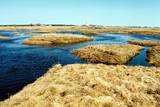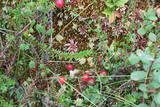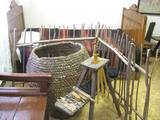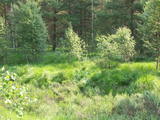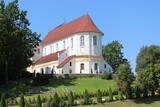| Нo | Название | Описание |
|---|---|---|
|
This is one of Estonia’s most beautiful karst fields, covering 125 hectares which feature different karst processes – subterranean streams, the dry Jõelähtme River bed, karst streams, funnels, ditches, caves, cliffs, a unique rock “mushroom,” etc. During the spring, the field is flooded, but at other times of the year, its contents are easily visible.
|
||
|
Могила Менессмейтини Райниса (Иды Апсане) находится на старом лютеранском кладбище (в 0,2 км к северу от Лашской лютеранской церкви). На памятнике И. Апсане помещен следующий текст: «Ида Марие Aпсан род. 23 марта 1867 сконч. 10 апреля 1887». На Лашском кладбище захоронены и другие члены ее семьи.
|
||
|
Atrodas Īvandes dienviddaļā, Vankas upītes krastos. Ūdensdzirnavas celtas 1842. gadā (par to liecina arī sienā iemūrēts dzirnakmens) un darbojas joprojām. To iekārtas ir saglabājušās no 1930. gada. Divstāvu ēka apskatāma no ārpuses, bet iepriekš piesakoties, - arī no iekšpuses. |
||
|
Маршрут предусмотрен для путешественников, которых привлекает большой и частый перепад рельефа, а также для тех, кто жаждет увидеть и на себе испытать впечатляющие берега глубокой древней долины Аматы, передвигаясь по мало тронутым лесным тропам. Тропа, проложенная на правом берегу реки, петляет как по нижней, так и по верхней части долины, поэтому местами необходимо преодолевать перепад высоты более чем 40 метров. Maršruta informācija no Latvijas Lauku foruma |
||
|
The territory has been established for protection of the bog and its habitat species. It is not appropriate for visits. North-east part of the bog can be slightly seen from the road Neveja – Lapmezciems on winter season. Further on Cirste direction is located on of most impressive oak trees in Latvia – Rigzemju ozols.
|
||
|
This pyramid-shaped hillock with an observation tower at the top of it was established by the Soviet military. It is along the Ķevele-Saldus road, where the Zvārde airfield used to be located. It was used as an observation facility to co-ordinate army training manoeuvres. There is a view of the former airfield and the massive forests of the Zvārde Nature Park and nature reserve. It is an appropriate location for bird-watching. Note that there are no improvements there.
|
||
|
Četrus kilometrus garā lokveida un marķētā dabas taka meklējama Plateļu pilsētiņas ziemeļaustrumu daļā. Tā ved pa dažādiem biotopiem – mežu, purvu, ezera malu, atklājot dažādas ainavas un tajās mītošās augu, putnu un dzīvnieku sugas. Šī ir interesantākā un ainaviskākā no Žemaitijas nacionālā parka takām. |
||
|
Das heute gesehene Ensemble (im Stil des Neorenaissance gebautes Gutshaus) entstand im wesentlichen in der Zeit zwischen 1897 – 1902 als ein Eigentum vom Grafen Joseph Tyszkiewicz und seiner Frau. Ein Park. |
||
|
В Усадьбе громкой тишины («Garsios tylos sodyba»), что стоит на склоне старицы реки Нявежис, производят «счастливую еду» из выращенных здесь же продуктов. |
||
|
Находится в Букупе (Салдусский край, Зирньская волость) в сельской усадьбе «Зики». Можно осмотреть коллекцию кино и фото экспонатов, собранную хозяином усадьбы Андрисом Бушинскисом. Коллекция включает старинные устройства для создания фильмов и предметы, демонстрирующие процесс фотографирования и киносъемки. Экспозиция размещена в бревенчатой постройке в виде пчелиных сот, построенной хозяином. |
||
|
Берег бывшего Балтийского ледникового озера. Мы можем только представить пейзаж, открывавшийся здесь более 10 000 лет назад, когда Курземский полуостров покрывала похожая на тундру растительность и волны ледового озера, в котором плавали айсберги разных размеров, бились о крутые берега. На сегодняшний день более чем 20-километровый (в Слитерском национальном парке – участок длинной около 9 км) и высотой до 42 метров обрыв является одной из наиболее впечатляющих форм рельефа такого рода в Латвии. У его подножия находится равнина Ирвес (название переводится с ливского „īrva, īra” –“лань”) приморской низменности – бывшее дно Балтийского ледового озера. Обрыв голубых гор во многих местах пересекают небольшие ручейки и речушки (Питрагупе, Лорумупе, Калькупе, Maзупе и др.), образуя разветвленные и местами очень сложные системы оврагов, которые особенно впечатляюще выглядят в безлистный период. Во многих местах на самих обрывах, на пересекающих их оврагах и их берегах обнажаются песчаники Нарвской свиты в основном небольшого размера. Это самые старые осадочные породы в Латвии, которые в виде естественных обнажений появляются на поверхности земли. Несмотря на впечатляющие размеры, по всей длине Голубых гор есть только несколько мест с точками широкого обзора (смотровая башня у Дундаги – дороги Мазирбе, вид с маяка Шлитере, вид с Межлидуми) и места, где можно по-настоящему насладиться величием древних берегов (вид на отвесные скалы и обрывы Голубых гор у дорог Цирстес-Мазирбес, Цирстес-Риепалду, Межлидуму и Видалес-Мелнсила). Сюда стоит приехать и весной, когда склоны Голубых гор утопают в яркой зелени черемши. |
||
|
Наутренский краеведческий музей. Постоянная экспозиция об
истории края, его культуре, образовании и истории волости.
Время работы: по договоренности |
||
|
This park covers the Nemuna River valley between the villages of Seredžius and Geldaudišķis, with lovely views of castle hills, medieval castles, aristocratic estates, etc., along the shores.
|
||
|
В мастерской можно познакомиться с керамической посудой различных этапов истории, изготовлением и применением предметов быта. Познакомиться с археологической керамикой, средневековой глиняной передвижной печью для выпечки хлеба, сковородой, кубками для питья, посудой паломников для воды. Все работы выполнены в технике лепной керамики и обожжены в дровяной печи. |
||
|
На обширных полях хозяйства под присмотром заботливого пчеловода «хозяйничают» ~ 150 семей пчел. Здесь выращивают и нектароносные растения – гречиху, донник, фацелию. Познание секретов пчелиной семьи, дегустация и покупка продуктов пчеловодства. |
||
|
The word grīnis in Latvian refers to a very unusual type of forest – pine trees growing on sandy soil. There are two types of this environment – the heather type and the grass type. This is the result of long-lasting interaction between nature and humankind, and such sites are found in just a few places along the shores of the Baltic Sea in Latvia. A very rare plant which grows in the area – cross-leaved heath – was the main reason why a nature reserve was established here in 1936. An abandoned former rail line between Ventspils and Liepāja crosses the reserve from the North to the South. Visits to the reserve are strictly prohibited. |
||
|
The Sunset trail starts in the centre of Saulkrasti town and takes you to the White Dune. Saulkrasti town with its municipal rural territory, occupies a 17km long stretch of coastal land to the North from the river Lilaste and the lake Lilaste. The White Dune stands on the right side of river Inčupe mouth. It is covered by old pine forest. The white, 18m high sand outcrop in olden times served as a landmark for fishermen. The White Dune formed as winds carried the sand from the beach over clay sediments of the Baltic Ice Lake. Some 150-200 years ago, the dune had been drifting as witnessed by several layers of soil buried within it. Local fishermen and farmers at Bātciems initiated afforestation of the drifting dunes. At that time, the 30m high dunes which are now covered with forest, were bare, shifting and even buried a farmstead. To speed up afforestation, mountain pines were planted. The White Dune was partly washed away in heavy storm in 1969, and 4-6m high precipice formed. Now the wind and sand have levelled out the dune surface, it has been fixed with willow-twigs or grown with forest where the largest pines are more than 170-190 years old. The pines are notable with their large trunks and branches, the scars obtained during their lifetime and the typical “crocodile skin” – the bark forms rhombuses resembling those of the reptile’s scales. Scots Pine (Pinus Silvestris) is one of the most common tree species in Latvia. It grows in dry, meagre sandy soil in dunes as well as in marsh. However, it does not stand overshadowing. Forest fires help pines to get rid of competitors as pine endures fire better than other trees because of its thick bark and high crown. The wood exudes resin and burned wounds close soon. Fire cleans space for seedlings of young pines. Pines can live 300-350 years. Ground cover in dune forests is very sensitive. If the sparse vegetation is destroyed, not only the natural biodiversity and landscape is damaged, but also the dangerous shifting dunes can possibly “wake up”. Embryonic dunes, White (yellow) dunes, Grey dunes and Wooded dunes are EU protected biotopes. Grey Dunes are protected by Latvian law as well. |
||
|
Guided wilderness experience day-trip combines bog shoeing and canoeing. First is walking through the forest and reaching the largest peat-bog in Estonia – Kuresoo. Wear bogshoes and walk on the wild landscape, followed by wilderness lunch. The trip ends with a relaxing canoe trip along Soomaa meandering rivers. |
||
|
Taka, kas izveidota Lemmjegi (Lemmjõgi) un Raudnas (Raudna jõgi) satekas vietā, iepazīstina ar palieņu pļavām un veciem pārmitriem mežiem, kas ir vieni no lielākajiem Igaunijā. Takas sākumā dominē atklātas lauku ainavas. Viens no 4,9 km garās lokveida takas apskates objektiem ir Lemjē dižozols. Mitrā laikā noderēs ūdensizturīgi apavi. |
||
|
Находятся в южной части Скайсткалне, направом берегу долины Мемеле. Церковь(стиль барокко) называют красивейшим храмом католиков в Земгале. К осмотру представлен богатый интерьер, а также гробница священников и дворян. |
||
